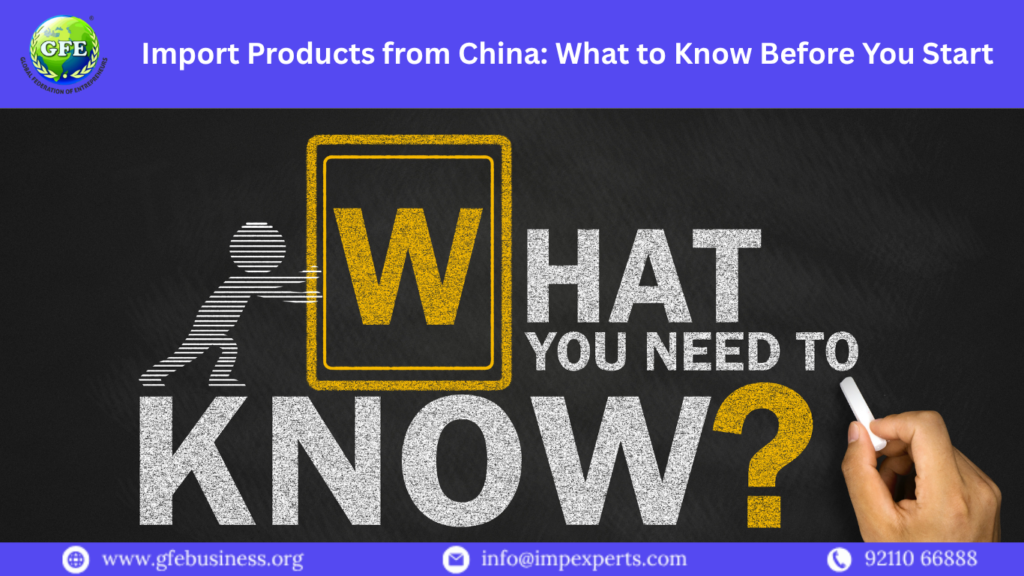China is the global hub for affordable manufacturing. Whether you want to import electronic gadgets, tools, garments, accessories, or packaging materials, China remains the most common source for Indian importers in 2025.
However, before you jump into your first shipment, you must understand how the process works — both legally and commercially. In this blog, we’ll cover everything you need to know to import products from China smoothly and profitably, especially if you’re starting with a small or mid-level budget.
At GFE Business, we guide Indian traders, students, and entrepreneurs to start importing and exporting the right way. This guide is built from real-time training insights and verified market strategies.
Why Import from China?
China continues to dominate global exports because of:
Low manufacturing cost
Huge product variety
Easy bulk availability
Factory-level customization
Digital sourcing platforms like Alibaba, 1688, and Made-in-China
You can import small tools at ₹20, sell them for ₹80. Import bags at ₹80, sell at ₹250. The margins are real — but only if the process is right.
Step 1: Understand What You Can and Cannot Import
Before placing an order, verify whether your selected product is:
Legally permitted for import in India
Not restricted by Indian customs regulations
Not under BIS or FSSAI restrictions (for specific categories)
Always identify the HS Code (Harmonized System Code) of the product and check the import duty structure. For example:
| Product Type | Estimated Import Duty |
|---|---|
| Electronics | 20–30% |
| Kitchen tools | 18–28% |
| Garments & fabrics | 10–20% |
| LED products | 35–45% |
At GFE, we help traders find the right HS codes and verify restrictions before committing to a product.
Step 2: Get Your Import Business Documents Ready
You don’t need a big office or degree — but you must be registered. To legally import from China:
Register your firm (Proprietorship, Partnership, or Pvt Ltd)
Get a GST number
Apply for IEC (Import Export Code) from DGFT
Open a current account + register AD Code (for port clearance)
Optional: MSME Udyam registration for benefits
These steps are fast and affordable. GFE Business supports students and first-time entrepreneurs across India in completing them correctly.
Step 3: Find a Reliable Chinese Supplier
The biggest risk in importing from China is working with the wrong supplier. Always:
Use verified platforms: Alibaba.com, Made-in-China.com, 1688 (with agent)
Check reviews, trade assurance badges, and response time
Ask for real-time factory videos or certifications
Start with samples or small quantity trial orders
Never send full advance without verification
Pro Tip: Use freight forwarders or sourcing agents to inspect goods before shipment.
Step 4: Decide on Shipment & Logistics
Depending on your budget and urgency, you can choose:
Air Freight (fast, for 50–300 kg orders)
Sea Freight (economical, for 1 CBM and above)
Courier (DHL, FedEx, Aramex) for small urgent shipments
Consolidated shipping through third-party agents (ideal for small importers)
You’ll need to coordinate with:
Chinese seller or forwarder for shipping
Indian CHA (Customs House Agent) for clearance
Freight partner for tracking and documentation
Step 5: Know Your Import Documents
At the time of import, these documents are required:
Commercial Invoice
Packing List
Bill of Lading or Air Waybill
HS Code declaration
FSSAI/BIS/COO, if applicable
Importer’s IEC, GST, and AD Code details
Your CHA will file a Bill of Entry, and duties will be calculated accordingly.
We train importers with real-life document formats, checklists, and samples to avoid errors and penalties.
Step 6: Calculate Profitability
Always include these costs in your pricing before placing an order:
Product price
Freight charges
Customs duty + IGST
Clearance charges
Warehouse/storage costs
Transportation to your location
Expected selling margin (30–80%)
Let’s say you buy a kitchen tool at ₹40 + ₹15 shipping.
Total landed cost: ₹60–₹70
Resale price: ₹150–₹180
Profit: ₹70–₹110 per piece
Small batches, consistent supply, and high-demand products = sustainable profits.
Step 7: Avoid Common Import Mistakes
Many beginners lose money due to avoidable issues. Here are key tips:
Don’t skip GST or IEC registration — it’s legally mandatory
Always verify supplier credentials
Don’t under-declare invoice values — it can trigger customs issues
Use agents if you don’t understand Chinese language platforms (like 1688)
Don’t expect high margins from the first order — test and scale
Our students in Ahmedabad, Pune, Surat, and Rajkot have built profitable import businesses in 6–12 months by avoiding these traps.
Final Words
Importing products from China is still one of the best ways to start a scalable trading business in India. With low MOQs, high variety, and excellent margin opportunities, it’s ideal for traders, job-seekers, and digital entrepreneurs.
But remember: success in importing is about doing it right, not doing it fast. Follow the legal process, learn from working models, and build your import business one shipment at a time.
Visit 👉 www.gfebusiness.org and get the training, documents, and guidance you need to import legally and profitably from China in 2025.








